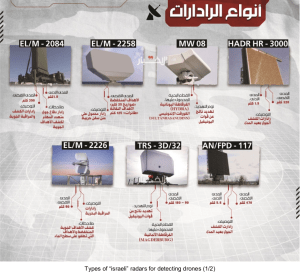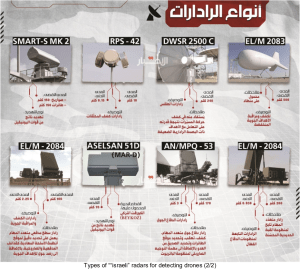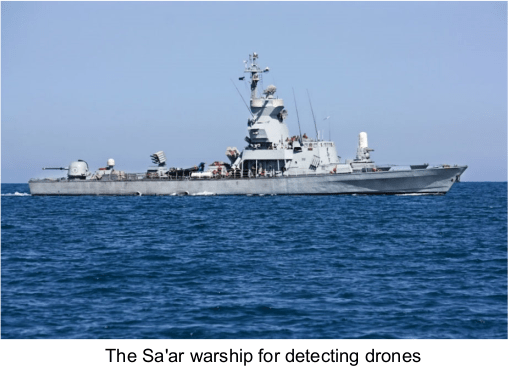4. Intelligence and Military Confrontation and High-Tech Systems: What Are The Details of the Electronic Warfare Between the Resistance and the Enemy?
The story continues:
1. Kings of the Sky! – The Story of the Air Force of Hezbollah
2. 30 Years… From Gliders to Drones, And From Syria to “Karish” to Al-Aqsa Flood
3. The enemy is haunted by the “Karar” drone: Hezbollah’s technical superiority has amazed our army and terrified us.
4. Intelligence and Military Confrontation and High-Tech Systems:
What Are The Details of the Electronic Warfare Between the Resistance and the Enemy?
5. Cost of Drones vs. Cost of Countering Them
6. The Hezbollah Drone Family
7. How did Hezbollah’s needle deflate the legendary balloon?
The leader in the resistance’s air force says, “Throughout Hezbollah’s efforts to enhance its capabilities in all aspects, it faced an ‘israeli’ war that people are not aware of. There was significant ‘israeli’ intelligence effort to determine what we were doing and what capabilities we had acquired. Over the years, the enemy has done many things to deter the resistance or deny it many things.”
He added, “During all this time, the enemy worked against us. It was expected that they would put all their efforts into preventing us from forming an air force or air defense capable of facing the challenges with them. The enemy worked according to a multi-level program that included:
Firstly: Preventing us from arming ourselves with these capabilities. This involved threatening any company that cooperates with us or punishing it, and working on destroying production factories. The enemy attacked Iranian companies and threatened European companies, and tried to deceive us by
sending materials that would spoil the product. They succeeded in some of their attempts but failed many times. In this war, the enemy discovered that what they thought they had succeeded in was an illusion.
Secondly: Establishing a security and military program to prevent these capabilities from reaching the resistance in Lebanon, whether by bombing goods during their transit towards us or by targeting weapons in their locations before they could be used. However, what is happening today on the front
lines indicates the level of the enemy’s failure.”
The jihadist leader adds that the enemy, “after acknowledging that these capabilities are now available to us, resorted to new steps focused on the world of technical intelligence, using various types of detection radars, including the Iron Dome 2084 Elm radar, the Patriot radar which has proven to be a failure and seems to be on its way out of the field with the announcement of its failure, and the tactical radars relied upon more against low-altitude drones like the RPS 42. Additionally, they rely on ‘friendly radars’ such as those from UN teams and countries in the region.


According to the same leader, the enemy has “utilized Saar-class warships of various types, equipped with radar systems like ‘Eider Alpha’ and others to detect aerial objects. They also rely on cameras, having seven types of optical and thermal cameras, which they have deployed in their strategic areas, especially along the border with us. Hence, from the very beginning, and still today, our work has been focused on destroying them.”
Another dimension of this confrontation, as highlighted by the jihadist leader under the title “Electronic Warfare,” is as follows: “The enemy decided to adopt the ‘soft kill’ approach, which is effective, low-cost, and has significant impact. They relied heavily on it. Their disappointment today stems from their failure
to benefit from this principle. They worked on seven layers of electronic warfare. We know that the experts in the entity, whom we are familiar with, are currently experiencing hours of disappointment because they had relied on this system and were overly confident to the extent that they believed they would not need to activate the Iron Dome against drones.”He adds: “Over time, the enemy shifted to a ‘hard kill’ strategy, which involves a system using technical
tools and directed weapons, such as the Patriot systems, the Iron Dome, and air defense weapons (Spider-Debby). Additionally, they have employed various helicopters and fighters, and now they have added the Vulcan (Sky Hand), which is a machine gun capable of firing 6000 rounds per minute.
However, we are confident that this will not be effective against Hezbollah’s tactics.”
The leader in the air force says, “When we talk about electronic warfare, we mean there are methods to use the spectrum to either intercept or thwart drones, and these methods also have multiple levels.

What the enemy has done, even during exercises, includes:
First: Jamming Global Navigation Satellite Systems (GNSS) and GPS. “israel” is among the most skilled countries in the world in this field. When they do this, it affects global navigation. But we were aware of their programs. Therefore, we thwarted their project and prepared surprises for them.
Second: Spoofing the GPS system, making the aircraft navigate without a real target, while the enemy provides it with a false location (spoofing). For example, if there is a drone in the southern airspace, it would be indicated as if it were in Beirut. This is an old method.
Third: Jamming drone control mechanisms. This was based on their monitoring of our operations during the Syrian war, and they launched a jamming operation aimed at reaching and controlling the aircraft themselves.
Fourth: Attempting to prevent the control center from receiving images from drones while they are in the air, by jamming the image-specific frequencies. But we surpassed this capability. If they want to know, we can tell them that we were receiving images while they thought they were blocking them.”
Fifth: Electronic interception of drones by attempting to intercept the control channel of the drones. If successful, the enemy would then control the drones instead of us and would proceed to destroy them. This is a known tactic in this field.

According to the resistance air force commander, “Since the 2006 war up to ‘Operation Al-Aqsa Flood,’ the enemy has continually engaged in large-scale exercises, both internally and concerning its forces. Their agenda has always included training to counter our air capabilities. They have focused on this
aspect more intensely since 2016, related to our operations in Syria, especially as we enhanced the role of drones and electronic warfare during that period. We also have our own information on the enemy’s evaluation of these exercises, which they claimed were successful. Even in 2020, they declared readiness to face any activity from us in the sky.
However, their current experience has shown that they were not successful, despite us working according to a precise level based on leadership decisions. They failed. The question before them is: How will they cope if we use what we have without constraints? How will they deal with multiple
weapons operating simultaneously, including drones, missiles, air defense, and other weapons, especially since they have used tons of explosives without successfully disabling the drones?”
The commander adds that the enemy “relied heavily on early electronic detection. They detect the drone directly after launch based on the signals it emits. They were capable of this through ‘SIGINT’ systems, which allow them to pick up drone signals even if they are far away, and to detect the aircraft even if its
RCS (Radar Cross Section) is small, as we tested from the far reaches of the Bekaa. We even tried this during the negotiations on maritime borders. On that day, we sent a drone over the ‘Karis’ field, and the enemy had to deploy a large number of warplanes (F-16 and F-35). What happened that day was that
the enemy detected the signal but could not locate the drone, causing a major uproar in the entity.”
The commander reveals “another matter, which is that the enemy deceives itself and its public when justifying the failure to intercept our drones due to their short distance or the proximity of their launch site to the target. Some drones, like those targeting the ‘Tal Shamayim balloon, traveled dozens of
kilometers even before entering their airspace. Yet they failed to detect them, and they reached their target. This refutes their justification. We know that there is no place in Palestine with the same density of detection and defense coverage as in northern Palestine. Therefore, the enemy should consider that
if we can breach northern Palestine and hit these targets, how much easier it would be to do so in the interior, in “Tel Aviv”, “Eilat”, and farther cities? It is much easier than bypassing Nahariya or reaching Haifa.”
The commander calls on people to “understand well that the enemy deploys all its intelligence, defensive, and collection tools against us. They have reinforced their presence there. Before the war, they had 3 radars for small signatures, and when we began operating drones, the number increased to 18 radars, and then to 23. Today, there is no valley or depression without a radar, which is unusual for armies. Despite all this, our drones ‘cut through and enter and exit’… We are constantly working on improving tactics, techniques, and developing them. On the level of weaponry, we rely on our own
special tactics. It’s like a game of chess. Even though they have made improvements, we always stay one step ahead.”




